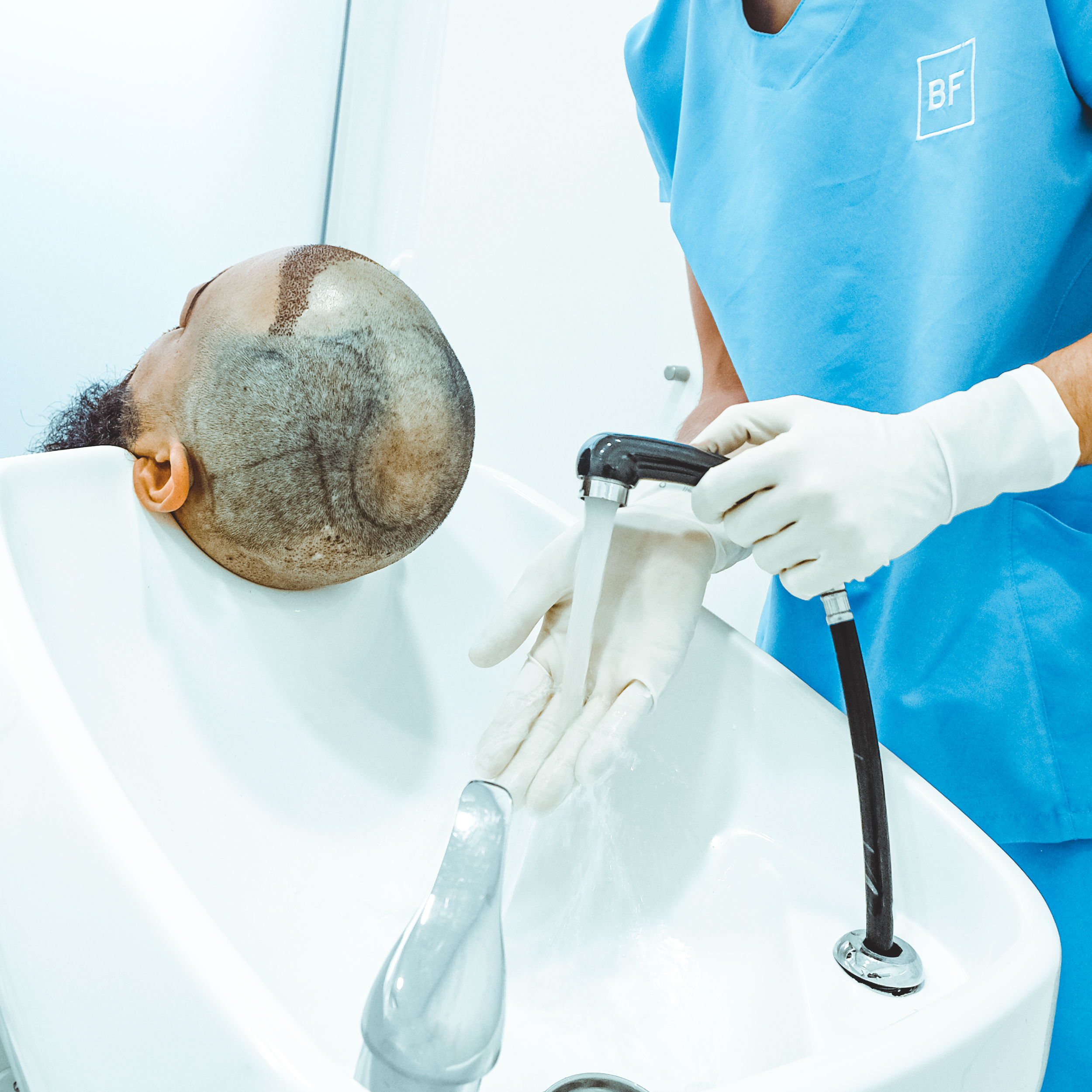THE SURGERY
-
FUE - Follicular Unit Excision - is a method of extracting naturally occurring groups of one to four hairs (called follicular units) from the scalp or other parts of the face and body for later transplantation into areas where they are wanted/needed. This extraction is usually done using a circular scalpel, called a punch. It can either be done using a manual or motorized punch.
When it comes to scalp hair transplantation, extraction in done within an area called the Safe Donor Area, which is an area in the occipital-parietal scalp that is not subject to androgenic alopecia (some exceptions apply). This is the hair used to reconstruct or restore the areas in need of hair. It is virtually scarless, as the scars left by a very small punch are usually very tiny and imperceptible even with hair as short as five millimeters.
For this procedure, hair must be shaven down to less than a millimeter to permit extraction, as it must fit inside the punch.
-
Dr. Ferreira performs all stages of the procedure. He does have an elite team of nurses assisting him, but all extractions, implantations and incisions are done by Dr. Ferreira.
-
Dr. Ferreira has been performing Hair Transplant Surgery exclusively for 10 years.
-
Dr. Ferreira performs 1 surgery per day on a single patient, as they usually last between 8 and 10 hours.
-
That depends entirely on the patient’s hair characteristics and the desired result in the recipient area. Dr Ferreira uses punches ranging from 0.65mm to 0.9mm. The most commonly used size is 0.8mm. It’s small enough to be gentle with the donor area but not so small so as to damage the grafts. If hairs are thinner or the follicles bundled together, then it’s perfectly safe to go lower. A smaller punch is also something Dr. Ferreira uses to get finer hairs for the hairline.
-
Yes, very. But Dr. Ferreira usually does not recommend partially shaven FUE. It depends on the extent of the surgery. For small and circumscribed cases, Dr. Ferreira will allow performing the surgery without shaving the recipient. For more extensive cases or diffuse alopecias he always advises shaving.
-
Naturalness is a primary concern. Using the right artistry and technique, we are able to achieve the much-wanted naturalness of the hairline and other areas. You will not be able to distinguish your transplanted hair from your native one.
-
Yes, it’s perfectly possible. As with any medical treatment or intervention, finasteride is given on a per case basis. Not all patients are candidates for finasteride. That doesn’t mean that a certain patient doesn’t need it. He can absolutely need it. But not all patients who have surgery need finasteride and not all patients who take finasteride need surgery.
-
All hair types can be used for a multitude of procedures. That doesn't mean they should. Chest hair would just be too thin to implant in the face/neck. Unless the patient has exceptionally coarse chest hair, it's not a good idea. There is also the matter of the hair cycle. Body hair has a much shorter hair cycle. Your wouldn't want that type of behavior for your beard hair.
-
Surgery is done under local anesthesia. You will feel the first pinches of the anesthesia being infiltrated, but after that, it is virtually painless.
-
Local anesthesia means than only the area being worked on is anesthetized. This means you may remain fully conscious during the whole procedure. It is however, very common for patients to fall asleep during the procedure.
-
We always shave the donor area for extraction. For the recipient area, it would be possible to perform it unshaven in certain cases. Dr. Ferreira decides this on a per case basis.
-
This can only be answered after thorough assessment by Dr. Ferreira. Please use our Consultation page to book either an in-person consultation or an initial online consultation.
-
The price includes all medical services (pre and post-operative care and consultations, surgery, medical follow-up), nursing (pre and post-operative care and consultations, surgery, post-operative washing, nursing follow-up), all surgical materials and consumables, photographic records and lifetime storage, meals at the clinic and a post-operative pack (includes: post-operative instructions, post-operative medication, saline solution bottles, compresses, post-operative shampoo, absorbent covers, instant ice packs, neck pillow).
-
There isn't a set limit, but Dr. Ferreira usually chooses to divide any cases above 2200-2500 grafts into two-day surgeries.
-
It depends a lot on how your donor area is. For the crown Dr. Ferreira tries to extract more triples and quadruples. But it depends on whether you have them. Some doubles and even singles always come out though.
-
Dr. Ferreira uses implanters for all implantations.
-
Our team of nurses use microscopes to analyze every graft extracted. Grafts are usually no longer than 2-3 hours of body. They're placed in a holding solution.
CANDIDACY FOR SURGERY
-
This can only be answered after a thorough assessment by Dr. Ferreira.
-
This can only be answered after a thorough assessment by Dr. Ferreira.
Didn't find the answer to your question here? Email us at info@brunoferreira.com.





